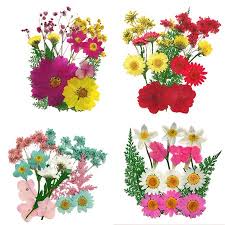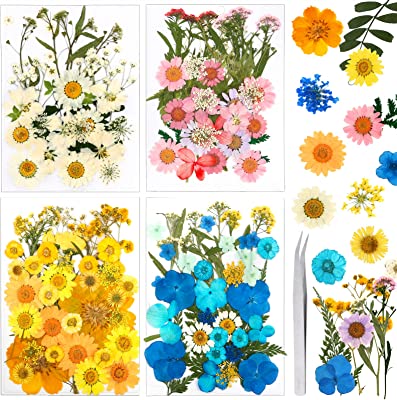Pressed flowers, like delicate whispers from nature, capture a moment of beauty frozen in time. These ethereal creations, carefully preserved through a delicate process, offer a unique and timeless way to appreciate the wonders of the natural world. The art of pressing flowers has been cherished for centuries, allowing us to bring the outdoors inside and bask in the charm of petals and leaves long after their bloom.
The process of pressing flowers is a labor of love, requiring patience and a gentle touch. Each delicate specimen is carefully chosen, plucked from its vibrant surroundings, and prepared for its transformation into a flattened masterpiece. The flowers are carefully arranged between layers of absorbent material, such as blotting paper or parchment, to ensure even drying and prevent discoloration. Then, gentle pressure is applied, either through the weight of heavy books or with the help of specialized flower presses, allowing time to work its magic.
As the days pass, the flowers slowly surrender their moisture, retaining their intricate shapes and colors while taking on a new, delicate texture. The process of pressing not only preserves the physical form of the flower but also captures its essence, capturing a piece of nature’s poetry within its petals. Each pressed flower becomes a testament to the ephemeral nature of life, a tribute to the transient beauty that graces our world.
Once the pressing is complete, the possibilities are endless. Pressed flowers can be transformed into stunning works of art, adorning greeting cards, bookmarks, and scrapbooks. They can be carefully arranged in shadow boxes or framed to grace the walls of our homes. The pressed flowers can also be used to create exquisite jewelry, encapsulating the essence of nature in wearable form. Their delicate presence adds a touch of elegance to any creative endeavor, infusing it with the grace and charm of the natural world.
Beyond their aesthetic appeal, pressed flowers hold sentimental value. They can preserve cherished memories, such as a bouquet from a loved one, a flower plucked from a special garden, or a blossom collected during a memorable journey. These fragile treasures serve as tangible reminders of special moments, allowing us to relive them and cherish them anew.
Pressed flowers have the power to connect us with nature, even in the most urban environments. They bring a sense of calm and tranquility, inviting us to pause and appreciate the intricate details of the botanical world. In a fast-paced and ever-changing world, pressed flowers offer a gentle reminder to slow down, savor the fleeting moments, and find beauty in the simplest of things.
So, whether you embark on the art of pressing flowers yourself or discover the enchantment of pressed flower creations crafted by others, let these delicate wonders inspire you. Let them serve as a testament to the delicate beauty that surrounds us, reminding us to cherish and protect the precious gifts bestowed upon us by nature.
Read Also: How often you need to Change Water in your Fish Farm
History And Significance of Pressed Flowers

The art of pressing flowers dates back centuries, with its origins rooted in ancient cultures that sought to preserve the fleeting beauty of flowers. The practice can be traced to ancient Egypt, where pressed flowers were found in tombs, symbolizing the belief in an afterlife and the eternal cycle of life and death. In medieval Europe, pressed flowers were often used to create intricate designs in books, known as herbaria, combining botanical knowledge with artistic expression.
During the Victorian era in the 19th century, the popularity of pressed flowers reached its peak. Victorians held a deep appreciation for nature’s beauty and embraced the sentimentality associated with pressed flowers. It became fashionable to create elaborate scrapbooks and albums adorned with pressed flowers, feathers, and other natural elements. These meticulously crafted keepsakes served as a form of personal expression and a way to commemorate significant events, such as weddings, births, and memorials.
The significance of pressed flowers extends beyond their aesthetic appeal. They hold cultural and symbolic value in various traditions and rituals. In many Asian cultures, pressed flowers have been used in religious ceremonies, where they represent purity, harmony, and the impermanence of life. They are often incorporated into offerings, altars, and shrine decorations.
Pressed flowers also play a role in scientific research and botanical documentation. Botanists and researchers use pressed specimens as a means to catalog and identify plant species. Herbariums, collections of pressed plant specimens, serve as valuable references for studying plant taxonomy, distribution, and historical changes in plant populations.
In contemporary times, pressed flowers continue to captivate individuals with their delicate allure. They have found their place in various artistic endeavors, including fine art, crafts, and even fashion design. Artists and crafters incorporate pressed flowers into their creations, experimenting with different arrangements, color combinations, and techniques to create stunning visual displays.
Moreover, pressed flowers have gained popularity as sustainable and eco-friendly alternatives to fresh flowers. They offer a way to enjoy the beauty of flowers without contributing to the demand for cut flowers, which often involves environmental concerns and ethical considerations.
The significance of pressed flowers lies in their ability to evoke emotions, create connections with nature, and preserve cherished memories. They serve as tangible reminders of moments and places, encapsulating the essence of a particular time and space. Pressed flowers can hold sentimental value, allowing us to revisit special occasions, reminisce about loved ones, or simply appreciate the intricate wonders of the natural world.
In addition, the history and significance of pressed flowers stretch across cultures, time periods, and artistic expressions. From ancient civilizations to modern-day creatives, the practice of pressing flowers has remained a cherished art form. Its ability to capture and preserve nature’s beauty, evoke emotions, and commemorate special occasions ensures that the tradition of pressed flowers will continue to inspire and enchant for generations to come.
Read Also: Find out: “Earthen Pond vs Concrete Pond” Which one is Better?
Types of Flowers That Are Commonly Pressed

1. Roses: with their iconic and romantic appeal, are often pressed to preserve their elegant petals and captivating fragrance.
2. Daisy: Daisies, with their cheerful and simple charm, are popular choices for pressing. Their flat shape and vibrant colors make them ideal for creating lovely pressed flower compositions.
3. Violet: Violets, known for their delicate purple or blue petals, lend themselves well to pressing. They add a touch of ethereal beauty to any pressed flower arrangement.
4. Sunflower: Sunflowers, with their large and vibrant flower heads, create striking pressed flower displays. Their bold colors and distinct shape make them a favorite for pressing.
5. Pansy: Pansies, with their velvety petals and intricate markings, are often pressed to capture their intricate beauty. They come in a wide range of colors, adding variety to pressed flower compositions.
6. Marigold: Marigolds, with their vibrant orange and yellow hues, are popular choices for pressing. Their sturdy petals retain their color well, making them long-lasting in pressed flower art.
7. Forget-Me-Not: Forget-me-nots, with their tiny delicate blooms in shades of blue and pink, are often pressed for their sentimental value. They symbolize remembrance and are frequently used in memorial keepsakes.
8. Lavender: Lavender, with its fragrant purple flowers and slender stems, is a popular choice for pressing. Its calming scent and soothing color make it a favorite for creating pressed flower crafts.
9. Orchid: Orchids, with their exotic and intricate blooms, are pressed to capture their intricate details and unique shapes. They add an elegant touch to pressed flower arrangements.
10. Geranium: Geraniums, with their vibrant and colorful petals, make beautiful pressed flowers. Their blooms can vary in shades of red, pink, white, and purple, providing a range of options for pressed flower art.
These are just a few examples of the diverse array of flowers that can be pressed. However, it’s important to note that not all flowers are suitable for pressing. Flowers with thick or fleshy petals, such as roses, lilies, and tulips, may not press well and can end up discolored or distorted. It’s best to experiment and explore different flowers to find the ones that yield the best results when pressed.
Uses of Pressed Flowers
Pressed flowers offer a wide range of uses, allowing you to incorporate their delicate beauty into various creative projects. Here are some popular uses for pressed flowers:
1. Crafts: Pressed flowers can be used in a variety of craft projects. They can be carefully arranged and glued onto greeting cards, bookmarks, and scrapbook pages, adding a touch of natural elegance to your creations.
2. Framed Art: Pressed flowers can be framed and displayed as standalone pieces of art. They can be arranged in a visually pleasing manner and framed behind glass to preserve their beauty. This creates unique and personalized wall decor that brings a touch of nature indoors.
3. Jewelry: Pressed flowers can be incorporated into jewelry designs, such as pendants, earrings, and bracelets. They can be encapsulated in resin or set in clear glass cabochons, allowing their delicate petals and colors to be admired up close.
4. Home Decor: Pressed flowers can be used to enhance various elements of home decor. They can be carefully arranged and pressed between glass panes to create stunning botanical art pieces. Additionally, they can be used to embellish candles, photo frames, and decorative trays, adding a natural and enchanting touch to your living spaces.
5. Wedding Keepsakes: Pressed flowers hold sentimental value and can be incorporated into wedding keepsakes. They can adorn wedding invitations, guest books, and place cards, adding a personal and natural touch to your special day. Pressed flowers can also be pressed from a bridal bouquet and preserved as a cherished memento.
6. Natural Stationery: Pressed flowers can be used to create unique and visually appealing stationery. They can be glued onto notecards, envelopes, and journal pages, transforming ordinary paper into beautiful and nature-inspired writing materials.
7. Botanical Art: Pressed flowers provide inspiration for creating botanical art. Artists can use them as references for drawing and painting, capturing the intricate details and colors of the pressed specimens in their artwork.
8. Educational Purposes: Pressed flowers have educational value as well. They can be used for botanical study, allowing students to examine and identify different plant species. Pressed flower collections and herbariums are also valuable resources for researchers studying plant taxonomy and biodiversity.
These are just a few examples of the many uses for pressed flowers. The versatility and beauty of pressed flowers make them a delightful medium for artistic expression and a unique way to preserve and showcase the wonders of the natural world. Let your imagination soar and explore the various ways you can incorporate pressed flowers into your creative endeavors.
Read Also: What Kind Of Plastics Can Be Recycled?
